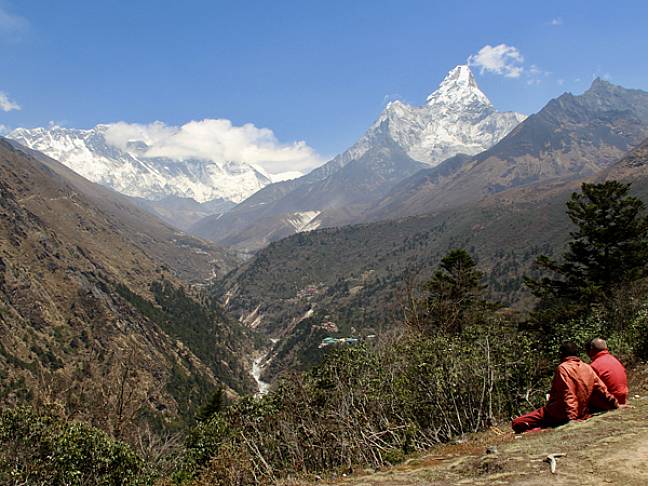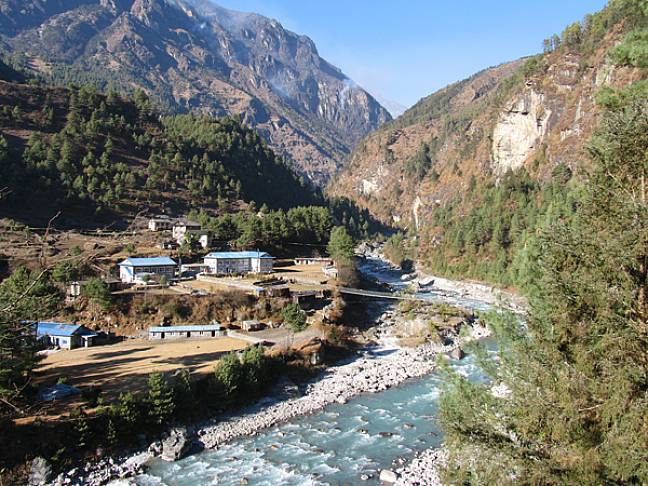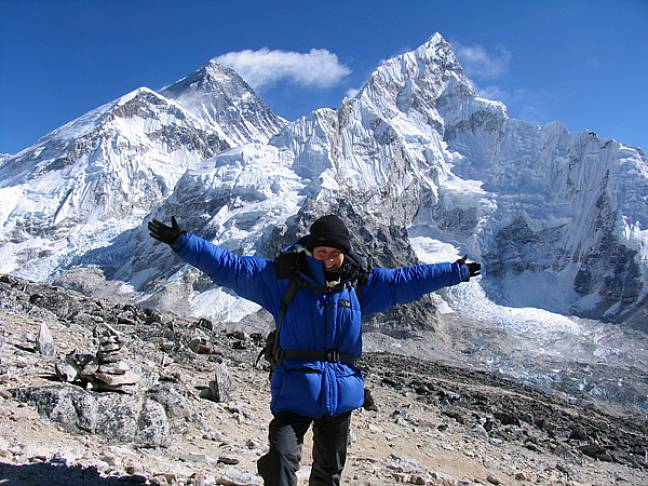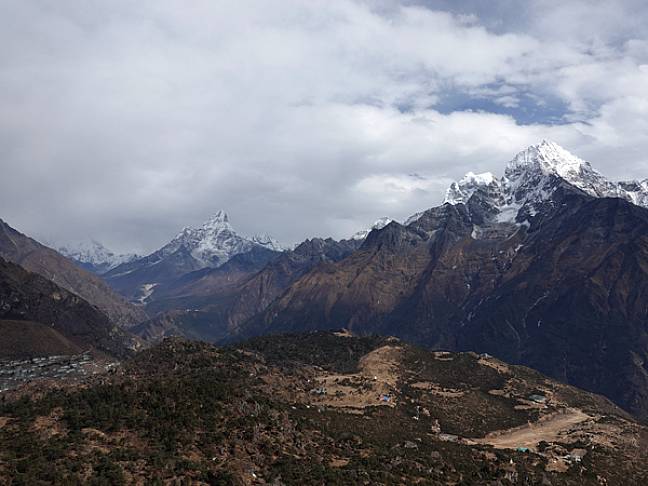What is the Best Time of Year to Trek to Everest Base Camp?
Everest Base Camp (EBC) is one of the world’s most iconic locations, and the trek to reach it is a bucket-list adventure for many. As one of the most sought-after and well-known treks in the world, it offers breathtaking views of the Himalaya and a chance to experience the unique culture of Nepal and the Khumbu (the Sherpa name for the Everest region). However, timing is crucial for an enjoyable and successful trek.
The best time to trek to Everest Base Camp depends on the season, as weather conditions can significantly impact your journey. Avoiding the monsoon season and understanding how the climatic variations will impact your trek ensures you pick the most favourable conditions for this unforgettable experience and maximise your chances of completing it.


An overview of mount Everest Base Camp weather
When planning your journey, understanding the weather is essential for choosing the best time to trek to Everest Base Camp. Although weather patterns the world over are more unpredictable, the Everest region still experiences distinct seasons, each with conditions that can make or break your trekking adventure.
Spring (March to May)
Spring is part of the Everest climbing season. The weather is mild, with daytime temperatures ranging from 10°C to 15°C at lower altitudes, though nights can be chilly sometimes dipping below 0°C. Clear skies - particularly in the mornings - that facilitate far-reaching views, and blooming rhododendrons make it a favourite for trekkers.
Summer/Monsoon (June to early September)
Monsoon season brings heavy rains, muddy trails, and reduced visibility due to clouds. The trails empty out, but leeches and unpredictable conditions pose challenges. It’s definitely not the best time to climb Everest Base Camp and it isn’t recommended.
Autumn (Late September to November)
The post-monsoon period is another fantastic time to visit, rivalling spring as the ideal trekking time. Daytime temperatures are comfortable, sometimes reaching highs of 18°C, although the evenings at altitude drop off to -8°C at times. The sunshine beams down which makes up for the strong winds that can make it feel cooler, and the skies are crisp and clear, offering stunning mountain views.
Winter (December to February)
Mount Everest Base Camp weather in winter is very cold, so you need to be prepared for these challenging conditions if you’re considering a trip at this time of year. Trekking provides solitude and incredible views, but temperatures can drop to -15°C or lower at EBC, especially at night.


The best time to trek Everest Base Camp
So, what are the best months to climb Mount Everest? Outside the monsoon months of June to September, most of the year offers trekking opportunities, but spring and autumn stand out as the best time of year to trek to Everest Base Camp. Let's delve into why.
Spring
Choosing the best time to trek to Everest Base Camp is key to enjoying this incredible adventure and spring is a top choice for many trekkers. The weather during this period is mild, with warm daytime temperatures and clear skies in the morning providing excellent visibility of the towering peaks. However, it’s worth noting that clouds often build up during the day, so the views aren’t as spectacular throughout the day. The trails are vibrant with blooming rhododendrons and verdant terraced fields in March and April, especially at lower altitudes along the fertile Dudh Khosi Valley, creating a picturesque setting.
Mid-March to April are the most popular months in spring, with consistent weather and the excitement of climbers heading to Everest's summit adding to the atmosphere. However, March is an excellent option for those seeking a quieter trek, as the trails are less crowded early in the season. May can be a good time to go, although the monsoon can sometimes impact the month with too much cloud. The downside to trekking in spring is its popularity, which means busier trails, packed tea houses, and higher prices for flights and accommodations.
Autumn
Autumn is equally ideal and perhaps an even more popular choice to trek to Everest Base Camp. The post-monsoon period offers crisp, clear skies and stable weather, making it perfect for capturing stunning views of the Himalayas. November is now widely regarded as the best month to climb Everest Base Camp due to its balance of warm days, cool nights, and breathtaking scenery. It was previously October, but due to climatic changes over the years, the monsoon season often ends slightly later than it used to so October can actually be quite unsettled.
However, this popularity comes with challenges, including crowded trails, limited accommodation availability, and higher flight and accommodation costs. It’s worth noting that accommodation availability would only pose a problem if you trekked independently - at Mountain Kingdoms we pre-book all of the teahouses or lodges we use so you’d never have to worry about not having a place to rest.
For those looking to avoid the busiest periods, late November to December offers quieter trails while still providing some of the most reliably clear weather conditions. It will be colder though, especially at night and at higher altitudes, but well-layered clothing, a good four-season sleeping bag and a warm duvet jacket will help keep you snug. At Mountain Kingdoms, we provide all of our trekkers with top-quality sleeping bags, liners, and down jackets. Also, the solitude and crystal-clear mountain views make it a rewarding choice.
Is Winter a Good Time to Trek?
Winter is not typically considered the best time to trek Everest Base Camp, but it can still be a very rewarding experience for those who are well-prepared and don’t mind the cold.
The highlights of trekking in winter include minimal crowds, offering solitude and a truly unique experience on the trails. Crisp, clear skies during this time ensure unparalleled views of the snow-draped Himalayas, making for stunning photographs and peaceful moments of reflection. Another advantage of trekking in winter is the lower cost of accommodations and services, as it is considered the off-season.
However, there are significant challenges to consider. Mount Everest temperatures in winter can plummet to -15°C or lower at Everest Base Camp, especially at night and at higher altitudes. This makes proper cold-weather gear, such as a four-season sleeping bag and insulated clothing, essential. Additionally, some tea houses close for the season, limiting accommodation options, and shorter daylight hours mean less time for trekking each day.
For those who embrace the cold, a Christmas trek to Everest Base Camp offers an alternative festive adventure and a genuine once-in-a-lifetime holiday experience. Kirsty Parsons, long-term member of the Mountain Kingdoms Marketing team, completed the trek at Christmas back in 2005 with her husband, and still considers it one of her most memorable Christmases ever. She vividly recalls the freezing cold nights and chilly days when they got above 4,000m, although it was surprisingly warm lower down the trail. The wonderfully warming Sherpa tea, morning porridge and cosy tea house dining rooms, with their hot stoves to huddle round, all helped to combat the cold. However, the skies were so clear and crisp, the views so sensational, and the trails so empty that it more than compensated for the ice-cold conditions. "Standing on top of Kala Pattar on Christmas Day, looking down onto Base Camp and up to the soaring summits of Everest, Lhotse and Nuptse - with every crag, ridge, glacier and col visible - was an unforgettable moment. To mark the day we sang our favourite Christmas songs as we trekked back to our tea house in Gorak Shep, and enjoyed tinned custard and fruit cocktail as a special festive treat after our dahl bhat. Never has a Christmas dinner tasted so good!"


When is the worst time to trek Everest Base Camp?
The summer months in Nepal mark the monsoon season and are widely considered the worst time to trek Everest Base Camp. While trekking is technically possible during this period, the general consensus is that the challenges outweigh the benefits.
Heavy rainfall is the defining feature of the monsoon season. This persistent downpour transforms trails into slippery, muddy paths, increasing the risk of accidents and making the journey more physically demanding. Landslides are also more common, especially in the lower-altitude regions, posing serious safety hazards. Dense clouds obscure the mountains, significantly limiting visibility and robbing trekkers of the stunning views that make the journey so special. The rain-soaked conditions also attract leeches, adding an unpleasant nuisance for trekkers.
Another major drawback of trekking during the monsoon season is the impact on travel logistics. Flights to and from Lukla, the gateway to Everest Base Camp, are often delayed or cancelled due to poor weather conditions, potentially disrupting carefully planned itineraries.
The only real advantage of trekking during the monsoon is that you will virtually have the trail to yourself, as few trekkers brave the rain-soaked trails. However, for most adventurers, it’s best to avoid this time and instead plan your trek during the Everest climbing season in spring, or autumn for better weather and a safer, more enjoyable experience.


Summary: comparing the seasons
When deciding the best time of year to trek to Everest Base Camp, both spring and autumn stand out as the ideal choices. Spring offers flowering trails, beautiful landscapes, and consistent comfortable daytime temperatures. The panoramic views are breathtaking, particularly in the mornings before the daytime clouds roll in and reduce visibility. However, spring’s popularity means crowded trails and tea houses, which can detract from the experience for those seeking seclusion.
In contrast, autumn features post-monsoon clarity, with crisp skies offering stunning views of Everest and the surrounding peaks often throughout the entire day. Temperatures are relatively mild, and the overall stability of weather conditions makes this another excellent season for trekking. November, in particular, is often seen as the best time to climb Everest Base Camp. Like spring, autumn can be busy and flight prices can be expensive, especially in peak weeks. For fewer crowds, late November to early December is a great alternative.
For those whose priority is solitude, winter offers this in abundance with breathtakingly clear skies, making it an excellent choice for trekkers who can handle freezing temperatures. Compared to the monsoon season, winter is a far better option. While winter poses challenges such as icy trails and some tea house closures, it avoids the rain-soaked, leech-filled trails and dangerous landslides of the monsoon season. The monsoon’s limited visibility and travel disruptions make it the worst time to climb Mount Everest, while winter rewards the prepared with peace and stunning views.
In summary, when considering the best months to climb Everest Base Camp, consider your tolerance for crowds, temperatures, and personal preferences for the landscape. No matter the season you choose, careful planning is essential. With the right timing and preparation, your journey to Everest Base Camp will be an unforgettable adventure.
If you’re interested in tackling Everest, Mountain Kingdoms offers a variety of fantastic Base Camp trips and holidays, all led by our expert guides. If the choice is overwhelming, or you simply want to find out some more information, contact our friendly team who will be more than happy to answer any questions.
This blog was written by Marketing & Product Manager Jude Limburn Turner, who has trekked and travelled extensively in Nepal. She has trekked many of the classic treks in the Everest and Annapurna regions and also gone well off-the-beaten-track. Among her favourite treks are the Manaslu Circuit and remote Kangchenjunga North & South Base Camps. Most recently she visited with her young family to trek between the luxury lodges of the Annapurna foothills.